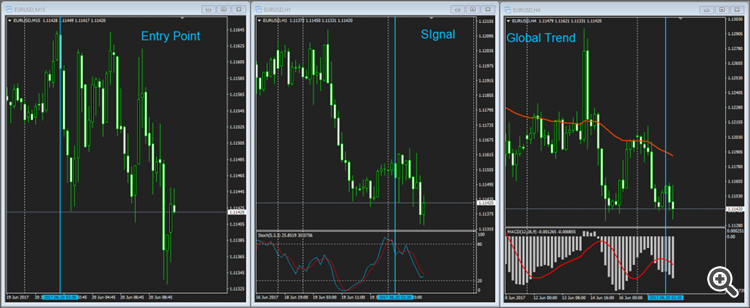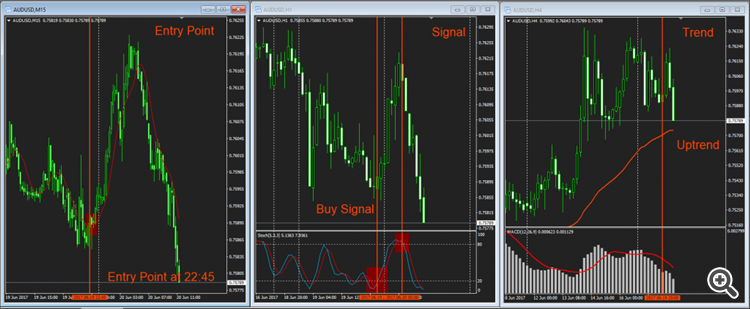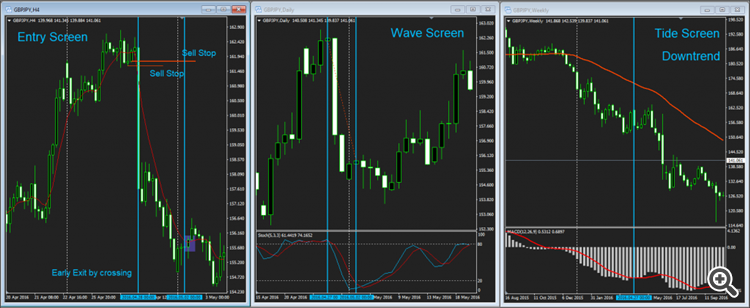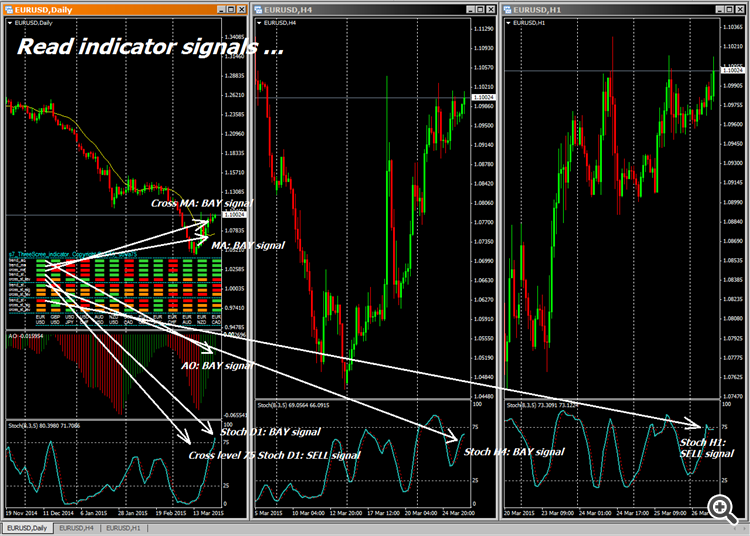CONCEPT OF TRIPLE SCREEN
Three Screens concept consists of three phases: Tide – use higher-period screen to determine current trend; Wave – use middle-period screen to determine signal; Entry – lower period to determine the exact entry point for the trade. Each screen uses suitable for its purpose indicators. There is no particular rule for the timeframes distribution for three screens. However, we picked popular among trader’s variations:
Intraday Trading:
- Entry Screen – 15 min chart
- Wave – 1 Hour chart
- Market Tide – 4 Hours Chart
Long-term Trading:
- Market Entry – 4 Hours
- Wave Screen – 1 Day
- Market Tide – 1 Week
Scalping:
- Market Entry – 1 min
- Wave Screen – 15 min
- Tide Screen – 1 Hour
Entry (Lower period) screen uses crossings of the price and short MA to determine entry points. While working on the Entry screen traders consider only signals in determined by previous screens direction.
SETUP
Open three trading screens of one Asset with the periods, mentioned above.
Entry Screen – Install Exponential Moving Average with period 9 (EMA(9))
Wave Screen – Install Stochastic with period 5 and k period 3 (Stochastic (5, 3, 3))
Tide Screen – Install MA with period 48(MA(48))
ENTRY RULES
- Determine trend direction on the Tide Screen. If Price is above MA – Uptrend, If Price is lower than MA – Downtrend. Some traders prefer to use MACD instead of MA.
- Determine trade signal with the help of stochastic on the Wave screen. Consider, that during Uptrend we only interested in Buy signals and during Downtrend we only seek for Sell signals:
- Buy signal: Stochastic lower than 20 level and crosses signal line from bottom to top.
- Sell signal: Stochastic higher than 80 and crosses signal line from top to bottom.
- When there are active Sell or Buy signal, the trader needs to concentrate attention on the Entry screen and determine correct entry point in the direction of the given signal. A soon as entry signal appears trader should open the trade:
- Buy Entry – crossing of the EMA by the Price from bottom to top
- Sell Entry – crossing of the EMA by the Price from bottom-top
SLIDING ORDER FOR THE ENTRY SCREEN
Classic strategy by Elder uses slightly different approach for the Entry screen. When Signal are determined trader follow the Sliding Order approach, using the lowest period screen (Entry screen):
- For Buy Signal: Place Buy Stop order slightly above High of the previous candle. If price does not trigger this trade during the current bar, move Buy Stop on the next High
- Sell Signal: Place Sell stop under the low of the previous bar. If the price did not trigger the order and next candle has opened – move the order to the next Low.
Such approach allows to catch impulse moves of the price and avoid stagnating periods.
If entry signal does not appear during the Signal from the Wave screen or even during the Uptrend state of the Tide Screen trader should cancel or Pending Orders and wait for another signal.
EXIT RULES
The strategy allows several exit rules. There are three main types exit rules: exit by Stop Loss, exit by Taking Profit and Early Exit rules.
STOP LOSS
Usually, Stop-Loss set with the help of the Entry Screen. Nevertheless, the trader can regulate the risk by switching Stop Loss rules among the three screens. These rules are listed for the Buy signal, for the Sell signal rules should be vice versa.
- Low Risk SL – Locate Stop Loss under the low of the previous bar.
- High Risk – Set Stop Loss under the Moving Average on the Tide Screen
TAKE PROFIT
Take Profit is the desired level of profit and must correlate with Stop Loss level. There are several ways to determine Take Profit (Rules for the Buy Order):
- Current price + k*StopLoss (k between 1.5 and 3)
- Local Price peak. Determined on the Wave screen
EARLY EXIT RULES
There are two Early Exit rules for Elders Momentum strategy: exit by the Wave Screen and Exit by the Entry Screen.
- Wave screen rule: exit the Buy trade when the opposite direction signal appears
- Entry screen exit: fix the profit of the Buy order, when the Sell signal appears (either price crosses EMA, or reaches Low level of the previous bar)
EXAMPLES
Here is the example of the Short trade on the Long-Term combination of the screens. Downtrend detected on the Weekly Screen. Stochastic gives Sell signal on the Daily (Wave) screen. On the Entry, screen trader uses Sliding Order technique to enter the trade. Early exit made by the crossing rule on the Entry screen.
TOOLS FOR WORK
Indicator MultiSymbol Triple Screen Trading System is used to trade on multiple currency pairs and monitors the signals from three time periods at once for 30 currency pairs and provides information in a graphical form on the same graph.







